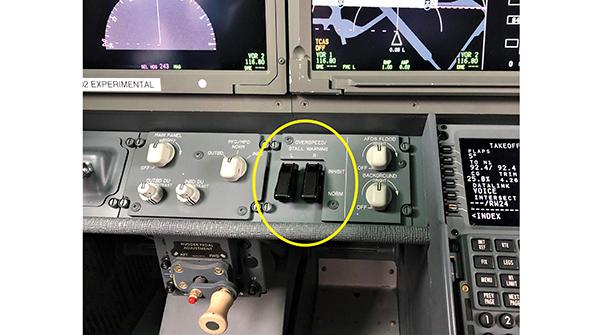
Boeing is preparing to add a third aircraft to the 737-10 certification campaign as the pace of testing accelerates for the final evaluation phase of the longest, and last, member of the MAX family.
- Cabin-configured 737-10 to join tests
- Stickshaker inhibit switches added
The third test aircraft, designated 1G003, is set to join the program amid company hopes that FAA certification can still be clinched by year-end, avoiding a congressional deadline that will otherwise require changes to the aircraft’s flight-crew-alerting system. Despite growing indications that regulatory approvals for both the -10 and its smaller sibling, the 737-7, may realistically slip into early 2023, no decision has yet been made about seeking an exemption.
Boeing Commercial Airplanes President and CEO Stan Deal acknowledged at the recent Farnborough International Airshow that the year-end certification target for the 737-10 is “very sporty,” but the company says its main focus remains on completing test points, submitting certification reports and “working closely with the FAA” on earning approval with the same crew-alerting system as used on the current 737-8/-9.
As of Aug. 23, the initial pair of 737-10 development aircraft had amassed some 730 flight hours on around 245 flights, of which the bulk have been accumulated by the first aircraft, 1G001. As well as evaluations of stability, control and overall handling, test work has focused on areas affected by the new design aspects of the stretched aircraft such as runway performance, braking, autoflight system checks and crosswind performance. Initial takeoff performance tests conducted at Edwards AFB, California, at the end of February included minimum liftoff speeds, rotation rates, takeoff distances and tail contact margins.
Boeing says this initial phase, which demonstrated that the 737-10 configuration will satisfy certification performance requirements and help determine takeoff performance parameters for the flight manual, was successfully completed. “The second phase is certification testing, and that will be conducted at a later date with the regulators,” it adds.
The third test aircraft “has already been in ground testing, and we intend to introduce it into flight testing later this year,” says Boeing. Configured with a full cabin, the aircraft will be used for interior systems checks including environmental control system work—augmenting similar checks already underway with the first two aircraft. As of late August, 1G001 was being used to conduct inlet temperature evaluations while 1G002 was undertaking smoke penetration tests of the cargo compartment—work traditionally done toward the tail end of the test campaign.
Another key test focus has been on the modified flight control computer software and enhanced angle-of-attack (eAOA) system introduced as part of the suite of improvements developed to allow the MAX to return to service following accidents in 2018 and 2019. Installed on the test aircraft early this year, almost six months after the first flight of the 737-10 in June 2021, the eAOA entered flight tests in March.
Developed at the behest of the European Union Aviation Safety Agency as a precondition for clearing the MAX’s return, the synthetic eAOA sensor collects AOA data from five aircraft parameters and provides a new safety feature by constantly cross-checking the derived angle-of-attack against inputs from the standard AOA sensors mounted on either side of the aircraft’s nose. If the eAOA detects it is receiving an erroneous signal from either of the standard sensor vanes, it is designed to suppress that input.
In both MAX accidents, issues with faulty AOA data led to repeated activation of the maneuvering characteristics augmentation system (MCAS), automatically adjusting the horizontal stabilizer. Although the FAA mandated changes to the MCAS to ensure the two existing sensors compare AOA readings and are within 5.5 deg. before triggering nose-down stabilizer inputs, other changes have also been introduced to address flight-crew alerting and reaction issues identified by regulators.
The main change visible on the flight deck—and publicly revealed only recently with the visit of test aircraft 1G001 to Farnborough—is the addition of new switches that will allow crews to inhibit nuisance stickshaker alerts without having to reach back and pull a circuit breaker on the panel behind them. The switches are installed in front of the captain’s (left-hand) position between the light brightness controls and background/flood light controls.
The added switches are also designed to address concerns raised by pilot groups about the potential dangers of distractions caused by the standard use of circuit breakers to silence the stickshaker. In addition, deactivating the stickshaker also will help crews improve recognition of a stall warning because the action, either via the new switches or the breaker, removes increased column forces applied by the 737’s elevator feel shift, which changes the control-column-feel force.
The eAOA-related switches are “being tested on the 737-10 with the intent to retrofit the system across the full 737 MAX family,” Boeing says. “The enhancements are designed to reduce crew workload by detecting and removing erroneous angle-of-attack inputs from the primary flight displays, as well as automatically inhibiting persistent crew alerts that rely on those data. These switches give the crew a second means of inhibiting the alerts.”






Comments
A MAX 10 ER would eliminate that competition, and allow customers to choose more 10s in each tranche, without, ahem, range anxiety.